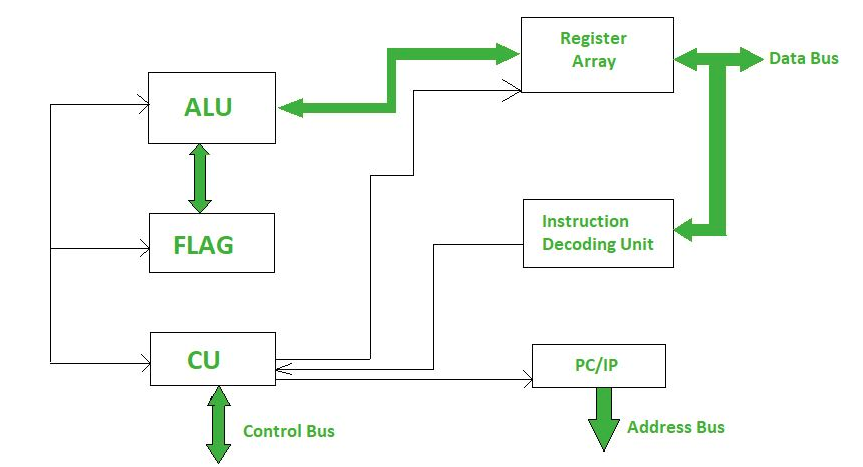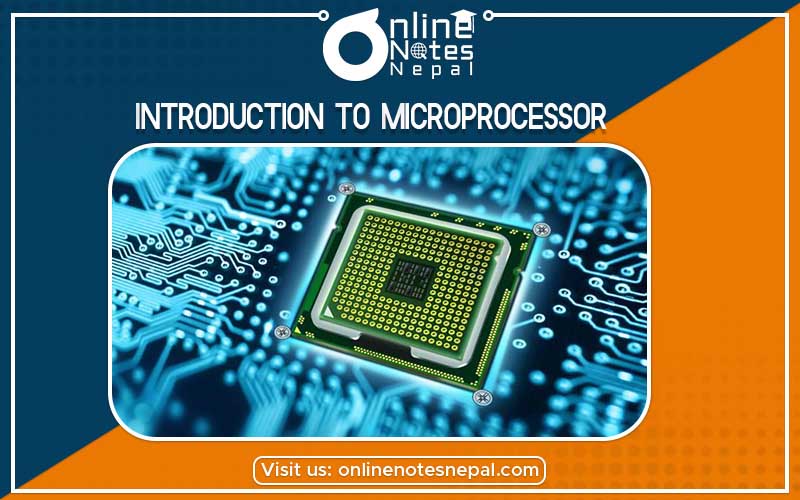Introduction to Microprocessor
A microprocessor is a multipurpose, programmable, Clock-driven, register-based electronic device that reads binary instructions from a storage device called memory, accepts binary data as input and process data according to the instructions, and provide results as output.
In other words, a microprocessor is a chip containing some control and logic circuits that is capable of making arithmetic and logical decisions based on input data and produces the corresponding arithmetic or logical output.
It is an electronic component that is used by a computer to do its work. It is a central processing unit on a single integrated circuit chip containing millions of very small components including transistors, resistors, and diodes that work together.

A typical programmable machine can be represented with four components: Microprocessor, memory, input and output as shown in the figure above.
Application of Microprocessor
Microprocessors are used in many devices in the modern world, but the application of the microprocessors can be broadly classified into two groups i.e. reprogrammable and embedded.
Personal computers, Servers, notebook, smartphones etc. are the reprogrammable application of microprocessors.
Home appliances. Machinery, automated systems, communication devices are examples of the embedded application of microprocessor. The microprocessor inside the embedded system is also known as the Microcontrollers.
Evolution of Microprocessors
- Intel developed and delivered the first commercially viable microprocessor way back in the early 1970s: the 4004 and 4040 devices. The 4004 was not very powerful and all it could do was add and subtract with 4-bit data only at a time.
- Intel rapidly followed their 4-bit offerings with their 8008 and 8080 eight-bit CPUs.
- Intel started facing competition from Motorola, MOS Technology, and an upstart company formed by disgruntled Intel employees, Zilog. To compete, Intel produced the 8085 microprocessor. To the software engineer, the 8085 was essentially the same as the 8080 but had lots of hardware improvements that made it easier to design into a circuit.
- During the late 70’s Motorola’s 6800 series was easier to program, MOS Technologies’ 65xx family was also easier to program but very inexpensive, and Zilog’s Z80 chip was upward compatible with the 8080 with lots of additional instructions and other features. By 1978 most personal computers
were using the 6502 or Z80 chips, not the Intel offerings.
- The first microprocessor to make a real splash in the market was the Intel 8088, introduced in 1979 and incorporated into the IBM PC (which appeared around 1982 for the first time). If we are familiar with the PC market and its history, we know that the PC market moved from the 8088 to the 80286 to the 80386 to the 80486 to the Pentium to the Pentium II to the Pentium III to
the Pentium 4. Intel makes all of these microprocessors and all of them are improvements to the design base of the 8088. The Pentium 4 can execute any piece of code that ran on the original 8088, but it does it about 5,000 times faster!

